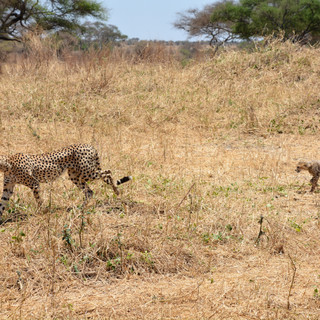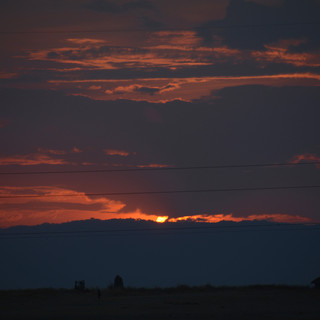Expedition!
- helenarheault
- Oct 3, 2016
- 13 min read
Hi all! I am finally back and have had the time to sit down and write about my camping expedition to Tarangire National Park. I had an AMAZING time! There are simply no words to describe the feeling of getting to watch all this beautiful wildlife in their natural habitat. If I’ve learned anything, it’s that nature will make you feel a whole array of emotions. If you pay close enough attention it will make you laugh, cry, feel inspired, awestruck, uncomfortable, humbled, and in some cases take your breath away. Whether it’s a giraffe awkwardly trying to run away and not trip over its own legs or an uncomfortable run in on two ostriches trying to do it in the middle of a grassland. Maybe it’s the sight of an orphaned baby elephant that makes you want to sob. Whether it’s the strength and wisdom that you can see in a matriarch elephant’s eyes as the years of nature’s burdens have made her the best leader for her family. It could be the beauty of every calculated step of a mother cheetah as every perfectly chiseled muscle moves her closer to her prey, and her piercing orange eyes carefully watch her surroundings. This was the moment that took my breath away. It was all these moments, whether I witnessed them myself or other students in other cars witnessed them that made me appreciate all the stories being told by mother nature whether it be comedy, drama, or tragedy.
Day 1
The morning of our first day of expedition we had about an hour and a half’s drive to the park entrance. From there we pulled in to a very confused warthog running around the visitor center area. While our professors were paying all the park fees, the students raided the gift shop when it was discovered that they had pringles, which aren’t always easy to find. Pringles are just about the only American snack food in Tanzania so basically people are willing to go to war over a can of mediocre tasting chips. I will shamefully admit that I am one of those people.
Once we pulled into the park we began our first assignment: to study elephant behavior. We drove around the park all morning looking for elephants identifying what social group they were in whether it be a group of bachelor males or females and young led by a matriarch. We had to determine the sex and approximate age of each elephant. There are a lot of different ways to determine the gender of an elephant but its most common to look at the ears and forehead. The forehead of a male elephant will be rounded, while a female will have a sharply edged one. A male’s ears will also go up past the top of his head, while a female’s ears will be aligned with the head. We also evaluated body condition, tusk condition, and saw if the elephants were stressed by the presence of liquid secreting from their temporal gland located between their eye and ear. What’s truly fascinating is that elephants are known to mourn their dead, so if you witness a group of grieving elephants they will most likely all be secreting this liquid, making it look almost as if they are crying. Elephants are incredibly social animals and remarkably fascinating to watch. The bonds that tie them together are unbreakable and within a few minutes of watching them you pick up on their incredible level of intelligence. You can feel that they are very aware animals and have a wide range of emotion that you might be privy too if you watch them for long enough.
After we finished this data collection exercise, we did a game drive in the afternoon. This was the first time I felt the true immensity of the African sun as it relentlessly beat down on us all day as we wizzed around the bumpy roads in our open top safari cars, welcoming the wind to cool down our faces. We saw incredible sums of wildlife from impala to gazelle, eland, waterbuck, reedbuck, giraffe, zebra, wildebeest, baboons, vervet monkeys, and more. Due to it being the dry season it is much easier to spot wildlife in the park and they are generally very close to the limited available water sources, such as the Tarangire River. This is where we were lucky enough to witness a mother cheetah and her cub. She was easily the most stunning animal I have ever laid eyes on. I wasn’t even sure if I was going to get to see a cheetah at all while being in Africa and here I was less than 30 meters away from a cheetah and her cub. Her beauty took my breath away and I felt that I was in a dream, which was a reaction I wasn’t expecting myself to feel for any of the animals, however fond I was of them. We watched her get up from behind a tree that her cub was perched in and silently sink down in the grass as she gracefully made her way closer to a group of zebras while her cub obediently trailed behind. She never made a run for the prey but unfortunately I think it was due to the fact that all the safari cars drew a lot of attention to her so her presence was given away. As much as I loved watching her and could have easily tracked her movements the entire day, I felt conflicted as this big pile up of obnoxious safari cars interrupted her peace. Witnessing this mother and cub, which my car named Serenity and Delilah, was the highlight of the entire expedition and I could not believe my luck.
As we drove around some more I realized how beautiful I found zebras to be. We saw SO MANY of them everyday, but I never got sick of seeing them. Their bold stripes are simply striking in person, and their bodacious behinds were always amusing to us. We also got to see a lot of waterbuck, which I grew relatively fond of. I describe them as being Africa’s version of a reindeer, but I also found them to be particularly beautiful animals. At one point, far off in the distance, we were lucky enough to see a lioness hanging out in a tree, which was my first lion sighting! I found giraffes to be very amusing to watch because they love to stare! No other animals would stand there and stare at you unwaveringly for as long as giraffes. Not to mention it is one of the most comical things to witness a giraffe trying to run away. I just don’t think they were built for that. Another oddball to watch is ostrich. You kind of just stop and look at it, tilt your head a little bit and go….that’s supposed to be a bird? Why does it look so goofy?
Later in the day we ended up back at the river where we saw the cheetah and watching intently as a lioness came down the hillside, looking hungrily at another group of zebra. We were all crossing our fingers and hoping to see her make a run, when all of a sudden, a waterbuck came out of nowhere and was very unaware of the fact that it was running straight at a lion. The lioness was caught by surprise but decided that might be a much easier bet, so she took of in pursuit. She had the easiest meal served to her on a silver platter but she was too lazy to fully commit to the chase! At one point they both stopped running and kindof just looked at each other and went their separate ways. Basically I saw the world’s dumbest waterbuck meet the world’s laziest lioness and it was quite the scene to watch!
At the end of the day before leaving the park we were given a lecture by a park ecologist on the way that the national park operates and is managed. After that we went to the research camp run by the SFS center director to see where he’s been running a lion conservation project since 2003. They showed us this big box with an identification card for almost every single lion in the park. I felt that I had just found the coolest job in the world. After a long day we arrived at our campsite that our staff was generous enough to have set up for us. I was so excited to finally get to sleep in a tent again. The camp itself was very comfortable as we had access to both running toilets and showers. Also, just for reference, our campsite was located about 15 minutes outside the park entrance.
Day 2
We had another bright and early start as we ventured back into the park. We spent the morning doing an animal counting exercise for my wildlife management class. There are three different types of protected areas that SFS students conduct animal counts in. These counts are done three times a year and have been done for the last five years. SFS can actually use this data to look at how the populations change annually and seasonally and among different conservation areas. I find it so cool that for what is meant to be a simple field exercise for class actually gets used to monitor population dynamic in a major national park. Anyways, I definitely nerded out over this exercise. Different cars drove in pre determined transects and we stopped the car every time we spotted wildlife to collect total numbers, number of adults vs juveniles, males vs females, behavior, and a few other pieces of data. I loved it! I felt that by the end of the day I could look at most animals and immediately identify it and its sex, which gave me a really accomplished feeling. Also, our transect was pretty remote so we got to enjoy the wildlife without a parade of other safari cars around.
At the end of our transects we had two options: turn around and go back the way we came or try a different more remote road. We opted for the new road and within 20 seconds of going down the road I burst out yelling for the driver to stop the car, for in this giant Baobab tree, a male leopard was sitting and watching us closely with his wary eyes not too far from the road. At this point I felt like the luckiest person in the world as in the last 48 hours I have laid eyes on three of the most beautiful cat species in the world: lion, leopard, and cheetah. Usually I am not someone to have immense sums of luck, but for whatever reason I have incredible luck with wildlife as my car was the only one to see a leopard on expedition. It is also very rare that SFS students ever get as close to a cheetah or a leopard as we did.
Another wonderful day was spent on a game drive. We got to see more lions much closer, and man they are beautiful animals too. At one point a group of male lions were hanging out under a tree, mostly concealed from our vision until a herd of elephants started charging them and sent them running in the opposite direction. Another crazy sight to see! Because I was over most of the initial excitement of seeing the animals from the day before, I was able to sit and really enjoy watching the animals, which I found to be very enjoyable and relaxing. It was a good reminder to me to put my camera down and just quietly see what the animals are doing instead of being too excited to go find the next thing.
In the middle of the day we stopped at this beautiful lodge for lunch were I spent most of the time sitting at the edge of this balcony that looked down over a breathtaking panorama of the landscape. From my chair I watched giraffes, elephants, zebra, wildebeest, and impala do their thing, totally unaware of my eyes watching from above. This was a very peaceful moment for me, being able to quietly watch the wildlife and be completely out of my own thoughts for a while. Overall it was another great day.
Day 3
At this point in expedition we were no longer going into the park. We went on a seven mile hike starting from the camp gates into the wildlife corridor that connects Tarangire National Park to Manyara Ranch, which is another protected area. The purpose of this hike was for us to practice building a wildlife habitat management plan based on the conditions of the corridor. Now let me say, this was the sorriest excuse for a wildlife corridor that I had ever seen. It honestly just made me sad to see such a vital piece of land required to keep protected areas from being completely isolated from each other in such poor condition. Local livestock had completely overgrazed the area so the grassland was mostly barren and dried up from no lasting water sources. There were almost no shrubs or trees, except for a century old Baobab tree that could only stand about a foot off the ground because it had been grazed on for so many years it could never grow into the towering giant it was meant to be. I think the image that will always stick with me is the body of a deceased young buffalo on the ground with no signs of life in either direction. We weren’t allowed to go near it because it had died of sickness and it could have possibly been Anthrax. When we got there we saw local dogs feeding of the buffalo which made me feel sick for the health of the dogs and those people that were about to interact with them, very unaware that they were feeding on a sick animal. The part of the hike that was more uplifting was when we came pretty close to a group of zebra. It was a new feeling to now be walking the same ground as the wildlife and it was thrilling.
The rest of the day was pretty relaxed. I spent a little while going to the local market where I finally got the authentic market experience. The village our campsite was in is mostly composed of Maasai people so besides all the fruits and vegetables the market was overflowing with traditional Maasai fabric and jewelry and it was a lot of fun walking around. My bargaining skills are fast improving!
Day 4
In the morning we ventured into Manyara Ranch for another animal count. Manyara Ranch takes a really unique approach to conservation because it calls for the coexistence of humans and wildlife. On ranch boundaries there is no human settlement so the land is primarily for the use of wild animals. However, the Maasai pastoralists are allowed to bring their livestock onto the ranch to graze. Unfortunately we didn’t get to have a lecture with management staff to learn more about how this particular conservation approach works. However, because of the livestock, we included wildlife in our counts this time and boy was it boat loads of fun to pull around a corner and have to count 200 cows. However, it was really cool to see wildlife one moment and happen upon some herders and their livestock the next. Here we got to see some lesser Kudu and one of the cars saw a gerenuk, which is an antelope with disproportionately long legs and long neck. It is considered the giraffe of antelopes and I was a little bummed I didn’t get to see it.
In the afternoon we did another interview exercise for my environmental policy class in the local village. We interviewed people to find out about how they use natural resources in the areas. This was the first exercise that I found myself really frustrated by. The guides that went with our groups were kind people that really wanted to practice their translating skills and help us with our assignment. However, the interpretation skills just weren’t there so we faced major language barriers between the families we interviewed and with our guides. As a result we weren’t able to control the course of the interview very well and not everyone in my group maintained an attitude of professionalism. Thus, we became a source of amusement to the local people. I felt bad for wasting their time as none of the information we collected was going to be used in any way that would benefit them. I was also very frustrated by the fact that we did not leave a good impression of what Americans are like. It is important to me how I carry myself here because I want people in Africa to have a good and accurate understanding of what American people are like. I do not want to be perceived as rude or foolish and the lack of professionalism during this exercise really hit my nerves on a personal level. This was the most frustrating experience I have had in Tanzania so far.
Day 5
This was our last day of expedition, so we had to break down camp in the morning. The rest of it was spent getting a lecture from management staff at the nearby Burunge Wildlife Management Area. In Tanzania, a relatively recent approach to conservation has been the development of Wildlife Management Areas. Other African countries have a similar type thing but they have different terms for it. Basically, a village or group of villages comes together and decides they want to set up a protected area that they are solely responsible for the management of. This form of conservation is referred to as community based conservation as it allows the people to be directly in charge of how natural resources are managed and how wildlife is utilized. It empowers the people to see the benefits of sustainable living and preserving biodiversity for themselves rather than being told by a bunch of conservationists that “wildlife is important so don’t hunt it and by the way, this land is no longer for you but for the animals”. The Burunge WMA is the most successful in the country with stable populations, regulated hunting, and consistent tourism. Last year they profited about $200,000, which was used to fund WMA operations and also go back to the community in various ways such as helping develop schools. Another awesome aspect of the WMA is that they require staff to run operations as well as the tourism brings in new market opportunities. This allows for the community as a whole to expand income opportunities and build a more developed, dynamic local economy. The crazy thing about all of this is that at the end of the day the wildlife benefits too because their resources are adequately managed and populations closely monitored. They also have a good grip on controlling illegal hunting and poaching. I was really amazed to see how this country and community in particular found a way to find such harmony between the coexistence of humans and wildlife to benefit both parties in such astronomical ways.
Seeing Manyara Ranch and the Burunge Wildlife Management Area really made me think about conservation approaches. In the states, we primarily use national parks. Naturally, my whole life I assumed this was the best way to preserve species. I have not considered before the various approaches and potential new benefits to different forms of conservation and wildlife management. What I loved so much about Manyara Ranch and the Burunge WMA was that it forces people and wildlife to regain a harmonious balance of coexistence. All of our ancestors’ co existed with wildlife since the moment we became a species and somehow throughout the centuries we have lost sight of this relationship. Sustainable coexistence is not only inevitable but required if humans or wildlife are to stand a chance on Earth. I think in America we have lost sight of this idea, whereas people in rural Africa have no choice but to learn how to co exist. Honestly, I think we need to take a lesson from Tanzania and other countries instead of us trying to push all our ideas on them. I was definitely reminded that there are so many great things happening in the world in the most unexpected places that privileged people like us could learn a thing or two from.
Anyways, after our talk with the WMA staff we made a few quick stops at the Burunge lake shore and stopped at a basket store. This small business is run by local women that hand weave baskets out of grass and sell them to tourists. This was just another great example of expanded market opportunities as a result of the WMA. The handiwork was amazing and I definitely bought a few to support the cause. After this, we drove back to camp where we are passed out very quickly into our beds after a long but wonderful expedition! I hope you all enjoyed hearing about expedition!











































































































































































































































































































































Comments